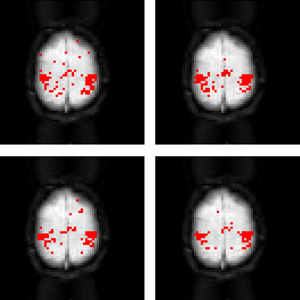
Motor cortex network recovery with agglomerative
clustering (top right), temporal mapping of proximity
(top left), Louvain method (bottom right) and spectral
clustering (bottom left).
We are currently developing a computational framework for exploring functional network connectivity and analyzing information transfer in the human brain, while simultaneously circumventing the inevitable information loss induced by contemporary techniques. To this end, we introduce a mutual connectivity analysis (MCA) approach that can handle non-linear functional connectivity analysis in large time-series ensembles obtained from resting state fMRI neuro-imaging studies. Our MCA approach starts with network identification through large-scale non-linear mutual time-series prediction using local simplex models, neural networks etc. The resulting affinity (or dissimilarity) matrices are then subject to non-metric clustering or graph-partitioning methods for network identification. In a last step, we also examine causal relationships between identified network components through the application of convergent cross-mapping.
We are currently performing validation studies with our MCA framework for purposes of recovering the primary motor cortex network associated with hand movement. Our end goal is to apply our framework for quantifying differences in cognitive functional connectivity between healthy subjects and patients suffering from HIV-induced cognitive impairment.
We have also developed a novel computational framework for large-scale Granger Causality (lsGC) Analysis. This method can be used to extract directed influence flow between every pair of time-series in a system in very large networks, such as whole-brain functional MRI data sets. A software toolbox for large-scale Granger Causality (lsGC) analysis can be found on the software page.
Journal Publications
- A. Wismüller, X. Wang, A.M. DSouza and M.B. Nagarajan, "A Framework for Exploring Non-Linear Functional Connectivity and Causality in the Human Brain: Mutual Connectivity Analysis (MCA) of Resting-State Functional MRI with Convergent Cross-Mapping, arXiv:1407.3809 [cs.NE] (2014).
- A. Wismüller, O. Lange, A. Meyer-Bäse, M.F. Reiser, and G.L. Leinsinger: Cluster Analysis of Dynamic Cerebral Contrast-Enhanced Perfusion MRI Time-Series IEEE Transactions on Medical Imaging 25(1):62-73 (2006).
- A. Wismüller, A. Meyer-Bäse, O. Lange, D. Auer, and D. Sumners, "Model-free functional MRI analysis based on unsupervised clustering," Journal of Biomedical Informatics 37(1):10-18 (2004).
- A. Meyer-Bäse, A. Wismüller, and O. Lange, "Comparison of two exploratory data analysis methods for fMRI: unsupervised clustering vs. independent component analysis," IEEE Transactions on Information Technology in Biomedicine 8(3):387-398 (2004).
- A. Wismüller, O. Lange, D.R. Dersch, G. Leinsinger, K. Hahn, B. Pütz, and D. Auer, "Cluster analysis of biomedical image time-series," International Journal of Computer Vision 46(2): 103-128 (2002).
Conference Publications
- DSouza, A.M., Abidin, A.Z., Leistritz, L., and Wismüller, A.: Large-Scale Granger Causality Analysis on Resting-State fMRI. Accepted for publication, SPIE Medical Imaging 2016
- Wismüller, A., Nagarajan, M.B., Witte, H., Pester, B., and Leistritz, L.: Pair-wise clustering of large-scale Granger causality index matrices for revealing communities. Proc. of SPIE 90381R (doi: 10.1117/12.2044340) (2014)
- A. Wismüller, O.Lange, D.P. Auer, and G. Leinsinger: “Model-free functional MRI analysis for detecting low-frequency functional connectivity in the human brain. Proc. of SPIE, Medical Imaging 7624-56, 76241M, doi 10.1117/12.843014, ISBN 9780819480255 (2010).
- A. Wismüller, A. Meyer-Base, O. Lange, T.D. Otto, and D. Auer, "Data partitioning and independent component analysis techniques applied to fMRI," Proceedings of SPIE 5439:104-115, (2004).
- A. Meyer-Bäse, D. Auer, and A. Wismüller, "Topographic independent component analysis for fMRI signal detection," International Joint Conference on Neural Networks 1:601-605, (2003).
- A. Wismüller, D.R. Dersch, B. Lipinski, K. Hahn, and D.P. Auer: A Neural Network Approach to Functional MRI Pattern Analysis - Clustering of Time-Series by Hierarchical Vector Quantization. ICANN’98 – Proceedings of the 8th International Conference on Artificial Neural Networks, Skövde, Sweden. Perspectives in Neural Computing (L. Niklasson, M. Bodèn, and T. Ziemke, Eds.), Vol 2, pp. 857-862, Springer-Verlag, London, Berlin, New York, 1998.